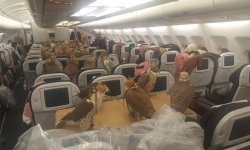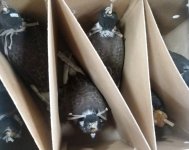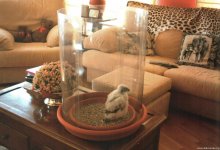The press statement from Natural England can be found here:
https://naturalengland.blog.gov.uk/2020/04/16/natural-england-issues-licences-for-taking-peregrine-falcons-from-the-wild-for-falconry/
The key points of interest:
- Number of licenses issued - three
- Number of young allowed to be taken in total - six
- Intended purpose - "to form a breeding programme with the other licensees."
Key conditions of license:
- young may only be taken from nests with three or more chicks
- smallest (weakest) chick must be taken from the nest
- applicants need to be able to demonstrate appropriate expertise and provision for the welfare of young taken, etc.
Rationale:
- to breed "verifiably British peregrines for use in their falconry activities";
- because "that birds already held in captivity cannot provide verifiably British birds."
- considered a sustainable use of species to fulfil cultural requirements (part of the European Commission’s Wild Birds Directive), providing this does not affect their conservation status.
----------------------------
The two most important factors relevant to the UK government's decision seem to me to be:
Impact on the UK peregrine population -
Ratcliffe's book (The Peregrine Falcon, second ed.), gives the following historic numbers for UK peregrine
breeding pairs - ie. not including non-breeders/floating birds:
- 1930-1939 (prior to World War II reduction measures) -1100 pairs (Britain and Ireland)
- 1961-1962 (height of the pesticide crash)- 44% of pre-war levels
- Early 1990s - 1265 pairs
- This number has since increased to 1769 pairs in 2014 (BTO 2014 peregrine survey).
Mortality rates have been estimated at about 30% for first-year birds, 25% for second-year birds and around 19% for fully adult birds. (Ratcliffe)
Given the above figures, the removal of six young in one year from the UK peregrine population has to be considered pretty insignificant - this species in the UK is not threatened/endangered to remotely the same extent as eg. the Bonelli's eagle in its European distribution or the Lanner in Italy. Illegal persecution likely accounts for a good deal more than six deaths in each of the most heavily affected UK regions.
Rationale for granting licenses etc.
More controversial than the numbers in question is the intended purpose for which the six young licensed per year are to be taken, and the rationale behind granting the licenses. Both are worth a thorough examination.
The purpose of taking these six young is, per the Natural England site:
- to breed "verifiably British peregrines for use in their [the licensees] falconry activities";
- and the licenses issued on the basis "that birds already held in captivity cannot provide verifiably British birds."
I appreciate that falconry - the hunting of wild quarry with trained birds of prey, as distinct from raptor-keeping and captive breeding - and its associated impact on wild bird of prey populations is a controversial subject. My own opinion, for what it's worth, is that I have no objections to taking six young from the UK peregrine population on the conditions set out under the Natural England license for
falconry as historically practised by British falconers.
I do however question the need for "verifiably British" birds, and the intention to use the wild-taken young for captive breeding. Historically, peregrines flown for falconry in the UK came from both British nests (juveniles captured just before fledging) and from Europe (the Netherlands, in particular, supplying many first-year juveniles captured "on passage" in the autumn. During the age of Empire a smaller number of peregrines of non-European subspecies came from assorted regions of the Empire, mostly the Indian sub-continent. Although young from certain UK locations (eg. Lundy) were formerly highly prized, British falconers flying peregrines have never confined themselves to "verifiably British" birds.
Captive breeding, likewise, has never been part of the historic falconry scene - which must be considered key to this issue as "ancient tradition", "cultural heritage" are given such prominence in the UK government decision and the EC Wild Birds Directive. The successful captive breeding of peregrines and other large falcons only came about in the 1960s, driven by the pesticide crash. Prior to the pesticide crash falconers obtained their birds from the wild, and kept them only for hunting.
To conclude my thoughts:
- Taking six young peregrines specifically for falconry - training them for flights at grouse, corvids, gulls, duck - I could not object to, providing licenses were issued to individuals with the experience and wherewithal to fly peregrines regularly at those quarry species (a demanding requirement, as not many individuals have the requisite combination of resources, time and ability). The numbers in question are small enough for the UK peregrine population to easily withstand (and a good percentage are likely to return to the wild after straying, etc.), and the intended purpose accords with historic UK falconry practice.
- Taking six young peregrines for captive breeding - although on the one hand the numbers involved and consequent impact on the population are exactly the same, the motives and purposes for which the birds are intended for demand close scrutiny because captive breeding is a significant depature from falconry as historically practised. Taking young birds for breeding stock aimed at producing birds for eg. the lucrative Arab market could not in any sense be deemed to "fulfil cultural requirements". Even if young birds produced are intended for UK and European falconers, the use of captive-bred young is not part of the historic culture of European falconry.
----------------------------
I wonder if the same individuals applying for licenses would still be interested if the following additional conditions were imposed:
- that licensees would have to collect the birds themselves (as I think is the case in the United States - where the US Fish & Wildlife Service considers that 144 first year individuals - as of 2017 - could be taken);
- that birds taken could be bred from in the off-season, but had to be flown at wild quarry unless and until incapacitated due to injury etc.
[TL; DR] - Falconers taking six young peregrines from UK nests is something I could live with, so long as the birds were flown at wild quarry regularly, and the license-holders went over the cliffs or buildings themelves...












